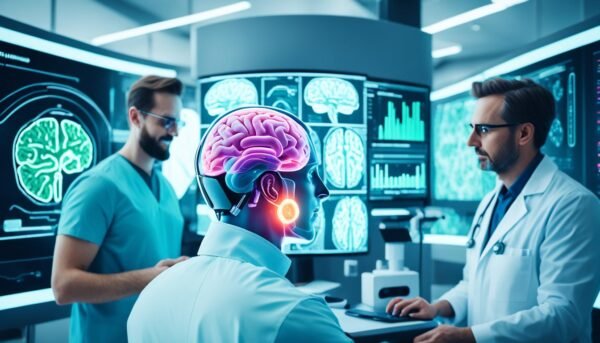Exploring the transformation in healthcare due to technology has been enlightening. I’ve seen the amazing progress of healthcare technology advancements. This growth is more than just new inventions. It’s proof of the hard work aimed at making patient care better. Now, digital health tools are changing how we approach healthcare, improving quality all over the United States.
The world of health tech is fascinating. From electronic health records to advanced diagnostic tools, these changes are crucial. They help provide better health results. Both doctors and patients now have technology that makes care efficient and easy. This is a time when health and technology join forces for a better future.
Key Takeaways
- The marriage of technology and healthcare is driving unprecedented improvements in patient outcomes.
- Electronic health records stand as pillars of modern patient care optimization.
- Diagnostic algorithms illustrate the pinnacle of healthcare technology advancements.
- The synergy of tech and healthcare delivery is a catalyst for quality enhancement in the medical field.
- Healthcare providers now have more powerful tools at their disposal to offer personalized care.
The Rise of Telehealth: Breaking Barriers to Accessible Care
Telehealth has quickly become a major part of healthcare. It bridges the gap between office visits and the need for ongoing care. The rise of telemed and virtual care is changing how we connect with doctors. Understanding these changes shows us the big picture of modern healthcare.
Understanding Telehealth Platforms and Patient Engagement
Telehealth platforms are at the core of remote healthcare. They offer everything from doctor chats to watching over patients from afar. These digital tools make it easier to get healthcare and less scary. They have simple designs and let you talk to doctors in real-time. Now, virtual care is key to keeping patients informed and cared for all the time.
Impact of Telehealth on Patient Outcomes and Healthcare Delivery
Telehealth does more than just change how we talk to doctors. It really helps patients and reshapes our whole health system. Through remote care, doctors can quickly step in when needed. This is huge for managing long-term illnesses or in emergencies. It makes healthcare safer for patients and helps clinics run better by easing their load.
Challenges and Opportunities in Telemedicine Advancements
But, telehealth also faces hurdles. Problems include not everyone having the tech needed, concerns about private data, and laws needed for telehealth. Yet, these issues also give us chances to make telehealth even better. By solving these problems, we can make healthcare more tailored, reachable, and efficient for everyone.
Wearable Health Technology: Monitoring and Personal Health Empowerment

I’ve grown fascinated with wearable health technology. These devices help with self-monitoring and health empowerment. From fitness trackers to advanced health systems, they encourage a hands-on approach to wellness.
I started my adventure with a fitness tracker to see its effects on my wellness. It showed my activity, sleep, and heart rate. This knowledge made me more mindful and motivated me to improve.
These gadgets are great for fitness lovers and also give essential health details. They help catch health issues early by checking vital signs and physical activities. This is all thanks to wearable devices.
| Device Type | Main Features | Health Benefits |
|---|---|---|
| Basic Fitness Trackers | Step count, Calorie burn, Distance | Encourages regular physical activity |
| Advanced Health Monitors | Heart rate monitoring, Sleep tracking, Stress Analysis | Early detection of potential health concerns |
| Specialized Wearable Devices | Blood pressure tracking, Electrocardiogram (ECG), Blood oxygen levels | Monitors critical health metrics for chronic conditions |
Health empowerment means taking control of our health data. Wearable tech makes this possible through self-monitoring. These devices could soon offer even more by linking with healthcare systems. This could improve care significantly, making it more personal.
Data Analytics in Healthcare: A Pathway to Continuous Quality Improvement in Healthcare
Healthcare data analytics is changing health and medicine. It helps in improving health predictions, treatment plans, and the healthcare system.
Big Data’s Role in Predictive Healthcare Solutions
Big data leads in creating predictive health models. These models help in stopping health crises before they get worse. Healthcare professionals use data to predict patient outcomes. This helps in saving lives and cutting healthcare costs.
Personalizing Patient Care Through Advanced Analytics
Advanced analytics make personalized medicine possible. Treatments match your genes, lifestyle, and health history. This approach makes treatment more effective and reduces side effects.
Improving Health Systems with Actionable Insights from Data
Healthcare data analytics finds problems and helps in making strategic plans for improvement. This leads to better patient care and more efficient operations. We see big improvements in healthcare systems.
| Aspect | Benefits | Keywords |
|---|---|---|
| Predictive Health Models | Early detection and prevention of diseases | predictive health models |
| Personalized Medicine | Customized treatment plans based on individual data | personalized medicine |
| Healthcare System Improvement | Optimized operations and enhanced patient care | healthcare system improvement |
Artificial Intelligence in Medicine: Revolutionizing Diagnostics and Treatment

The use of AI in healthcare is changing how we diagnose and treat illnesses. It can look through big amounts of data really fast. This makes machine learning essential in today’s healthcare. It makes diagnosing illnesses more precise and helps create AI-driven treatments. These treatments are tailored specifically to each person, making them more effective.
In real-life examples, AI helps doctors get better results for their patients. AI programs can read MRIs and CT scans more accurately. This leads to better diagnoses and fewer mistakes. Also, AI helps find diseases early on. This is when they’re easier to treat.
| Disease | Impact of AI | Outcome Improvements |
|---|---|---|
| Cancer | AI identifies patterns in genetic information and imaging | Higher precision in targeting treatment approaches |
| Diabetes | Continuous monitoring and management via AI algorithms | Improved glucose level management and patient quality of life |
| Heart Disease | Machine learning models predict cardiovascular risks | Early intervention strategies leading to decreased mortality rates |
AI-driven treatments make healthcare better in many ways. They make treatments more effective. They also lower healthcare costs by cutting down on extra procedures and hospital stays. AI’s role in making diagnoses more accurate is really important. It gives us hope for finding diseases early and accurately.
From what I’ve seen, AI in healthcare and machine learning will keep making big strides. They will push us towards a future where treatments are not just reactive. They will be proactive and able to predict problems before they happen.
The Emergence of 3D Printing in Medical Applications
I’m excited about how 3D printing is changing medicine. It’s making medical devices in new ways. It’s changing how we treat patients and making surgeries more precise.
Customizing Prosthetics and Implants Through 3D Printing
Customizing prosthetics is a big deal with 3D printing. Doctors can now make prosthetics and implants that fit perfectly. This means patients are more comfortable and the prosthetics work better.
Accelerating Surgical Preparations with 3D Models
3D printing is also changing how we plan for surgery. Doctors use 3D models to practice before the real thing. This makes surgeries faster and safer by knowing what to expect.
Bioprinting: The Future of Regenerative Medicine
Bioprinting is really exciting in 3D printing. It’s about making tissues and organs for medicine. This could change how we treat big injuries and diseases by growing new tissues for patients.
| Technology | Application in Medicine | Benefits |
|---|---|---|
| Customized Prosthetics | Creating limb and body part replacements tailored to patient anatomy | Improved comfort and functionality, enhanced patient recovery |
| Surgical Planning | Utilizing patient-specific models for pre-surgical rehearsals | Shorter surgery times, reduced risk, and better outcomes |
| Bioprinting | Constructing tissue structures for regenerative treatment | Potential for organ repair and replacement, pushing the boundaries of medicine |
Conclusion
Healthcare is evolving fast, thanks to new tech. Telehealth makes getting care easy and quick. Data analytics give deep insights that help improve patient care. People can now use devices to watch their own health.
AI makes diagnosing and treating diseases much better. Each of these changes is moving medical care forward. This means better results for patients.
Tech like 3D printing is creating new ways to treat patients. This was hard to imagine before. With telemedicine, and data solutions, care is getting better and more tailored. The future of health looks bright and full of hope.
Health innovations are changing care for the better. They offer a peek at an exciting future. These technologies change how doctors work and how people handle their health. I believe these changes will make healthcare better and more efficient.
FAQ
What are the latest healthcare technology advancements?
Electronic health records and advanced diagnostic algorithms are recent advances. Telehealth platforms and AI use also stand out. They improve diagnostic accuracy and create personalized treatment plans.
How do innovations in healthcare technology enhance patient care?
Innovations make patient care more efficient, effective, and personal. They allow early health issue detection. This optimizes outcomes and improves care quality.
What is telehealth and how does it improve healthcare delivery?
Telehealth uses tech to support healthcare over distances. It makes care accessible and convenient. Especially for those in remote areas or with mobility challenges.
Can wearable devices truly empower individuals regarding their health?
Yes, wearable devices give people health data. This lets them monitor themselves and take charge of their health. It aids in making informed health decisions.
What role does data analytics play in healthcare?
Data analytics is crucial in healthcare. It leads to predictive health models and personalized care. It also boosts healthcare systems by improving efficiency and outcomes.
How is artificial intelligence revolutionizing diagnostics and treatment in medicine?
AI boosts medicine by supporting more accurate diagnostics. It aids in developing AI-driven treatments. And it helps doctors make precise decisions with machine learning.
In what ways is 3D printing utilized in medical applications?
3D printing helps customize prosthetics and implants. It aids surgical prep with exact models. It might change regenerative medicine with bioprinting technology.
How might the future of healthcare be shaped by innovation?
Innovation will likely make healthcare more focused on the patient. It promises ongoing improvements in care, treatments, and healthcare quality as tech advances.
This post may contain affiliate links which means I may receive a commission for purchases made through links. I will only recommend products that I have personally used! Learn more on my Private Policy page.